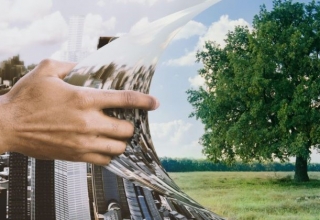
(excerpted from “Integral Leadership Coaching: A Partner in Sustainability” by Lloyd Raines, published March 2007, Integral Leadership Review.)
One of the things I have come to notice in my coaching is the panoply of ways people silence others, are silenced by others, or engage in self-silencing. Cultural influences, organizational practices, leadership’s individual behaviors and language, and the prevailing mental models may intentionally or unintentionally conspire to silence some while giving disproportionately powerful voices to others.
Each of us, knowingly or unknowingly, has silenced other people (or groups) at one time or another in our lives. Parents silence their children, couples silence their partners, one clique in school or adult life ostracizes another, cultural tribes silence other tribes – with words, physical gestures, rules, language, tone of our voice, a look, silence, shunning, turning away, moving towards, and many other subtle and obvious expressions.
What is the impact of silencing? It is a form of banishment, objectification, subordination, and systematic disrespect. It lets the other person (or group) know that they are not like the other, they are “less than.” It diminishes the humanity, dignity, intellect, heart, and hopes of silenced individuals and groups. And it broadcasts a pecking order where domination/superiority requires subordination – while being rationalized as showing proper respect for authority.
Often, individuals enter a hierarchical culture or subculture and gradually pick up a clear sense of deference by some to others. That deference may be based on position, location (the corner office vs. the cubicle), attire, and other characteristics of the dominant class. Those who abide by the cultural norms fit in, tend to get along well and advance, and those that ignore or challenge the norms risk being seen as disrespectful, insubordinate, and trouble-makers. Recognizing the risks of behaving outside the prevailing dynamics, individuals may choose to simply self-silence.
For coaches, when this phenomenon is present in organizational dynamics, it offers an opening for reflection and learning with the leader. The coach can offer observations that are noticed from interactions during meetings (who’s paid attention to, called on, and who is overlooked or cut short), or how the leader talks about and speaks with stakeholders and people at various levels inside and outside the organization. What’s gained and lost from these differential behaviors? What attitudes and assumptions give rise to those different behaviors?
I have found it almost always beneficial to start this kind of inquiry with a leader by asking him or her to recall a time when they experienced being treated as an outsider or second class by someone else in the organization. (Examples I hear often have to do with a person’s interactions with those with more power in an organization.) Or, in the case of women and minorities (racial, ethnic, religious, etc.), people of the same rank or even lower rank may subtly or not so subtly exclude and silence them.
Once I have called those memories forward for the leader, I ask him to tell me what emotion came up for him in those situations. It is often a combination of anger, fear, and sadness. (These emotions are ripe for exploration, and might easily uncover other related experiences that are helpful to ventilate.) I ask him to tell me the assumptions and judgments he feels were being made about him by the others; and then, what are the judgments he made about the others? I am curious to learn how his emotions, assumptions, judgments, and behaviors (in reaction to others’ behaviors towards him) affected his sense of self, his connection with the team, and his loyalty to the organization.
I have chosen to use a male leader here to anchor the meaning of being treated as “inferior” even though males are culturally dominant. Rejection or being diminished is commonly experienced by humans. By tapping into this deeply personal experience and bringing it to conscious awareness, I can use it as a bridge for appreciating the impact of his behaviors on others. Through his own sense of suffering, he is able to empathize with the experience of others on the receiving end of his dominating behaviors. Even more, it can generate a sense of mission around spearheading inclusive values and behaviors in the team and organization.
Cultural Blind Spots, Privilege, & Self-Interest
There is a blind spot that accompanies cultural privilege, and it is easy for good people to actively and passively behave in ways that reinforce privilege and the harms it perpetuates. I know I find myself regularly surprised by the power of my self-interested blinders when it comes to speaking or acting in the moment when I’m inappropriately benefitting from cultural privilege. I don’t mean to reinforce my privilege, yet it’s so easy to allow. It’s a hidden lottery that I cash in on without actively playing. I see it showing up regularly in world events, too.
I remember being struck by an article in the early days of the transition from apartheid to post-apartheid South Africa. Under apartheid, there were on-going efforts by black South Africans to establish a Bill of Rights to legally declare equality of the races. Had a Bill of Rights been accomplished it would’ve been a legal bulwark against the many cultural expressions of subordination suffered by non-whites. But, the culturally and politically dominant whites repeatedly repudiated the necessity of such laws. Upon the release of Nelson Mandela, his election to the presidency, and abolition of apartheid, one of the first petitions of the white minority, however, was to establish a Bill of Rights to protect their equality in the country where they were now the less powerful political minority. Moving from being the minority population that held dominant power to the minority population that no longer held dominant power shifted their self-interested perspective about the importance of legal protections for basic human and political rights.
The gravitational pull of our self-interest is substantial, and what’s tricky is that its warping effect is usually hidden until called out – perhaps by a reversal of fortune or from someone who names it. In virtually the entire developed world, men (and particularly white men) dominate. Within the cultural reality of patriarchy and racial dominance, each of us looks out at the world from the culturally defined messages associated with our gender, race, nationality, sexual orientation, ethnicity, age, class, educational level, and so forth within the dominant culture. Depending on who we are surrounded by, who we choose to surround ourselves with, and who we choose to be, those meanings can reinforce a feeling of value and empowerment or undermine them severely.
For coaches and the leaders we serve, these dynamics are often in play. Yet, in my experience, these old-school cultural dynamics seem to live mostly in leaders from the Boomer generation (and certainly the retired Veteran/WWII generation). And that makes sense. Even though Boomers were the generation that transformed the structural and cultural discriminations of race, gender, and sexual orientation, that history still lives on to some degree at the cellular level in that generation. As a Boomer myself, I see through that historical lens that persists in my body-memory. It’s part of a Boomers’ operating system and held in our hard drive memory. We knew and walked in the world when race and gender (and homosexuality) were at very different stages of awareness, cultural acceptance, beliefs, laws, and policies.
One major piece of good news is that with the passing of the cultural center of gravity from the Boomer generation to Gen Xers and the Millennials, diversity is experienced as normal and a strength instead of something to be struggled for or against. Gen Xers and Millennials are aided by having in their history and bones the shifts already largely established by the tumultuous civil rights and feminist movements. Their cultural center of gravity has shifted to inclusive, first class assumptions for all. These assumptions of equality, in other words, are largely unquestioned – they’re given. In fact, one expression of this is that many of the Millennial generation will move away from workplaces and communities that they experience as too culturally limited, moving towards the more catalyzing and generative effects they experience with diverse relationships and communities.
I remember a watershed moment of change when I was teaching justice-related classes at American University. About a third of the way into the course, we studied justice issues in the workplace. I had crafted an introduction that posed the paradox between American political beliefs and beliefs at the workplace. Basic political assumptions about democratic life (equality, fairness, and high levels of participation and decision-making throughout society) did not seem to be expected in the workplace. Up until 1987, this part of my introductory comments was met with a basic response: “get real.” I would ask students what seemed so unreasonable about that thought. They simply noted that the workplace was a dictatorship. That was the accepted view in the culture. Suddenly, though, in 1988, my introductory comments about the possible integration of democratic values into the workplace were met with this response: “of course, they must be.”
Just like that, within a year the tipping point of generational expectations had shifted. These students went into the work world expecting to be treated as active participants, not passive second class members of the organization. I didn’t see that change coming. It just showed up. In a sense it was below the radar screen, or at least below my radar screen. And it was but one example of changes emerging in diverse places throughout the culture, like crocuses in a new season.
A Species Blind Spot?
Having described the phenomenon of blind spots, imagine now what kind of blind spots we might have from a species point of view. How do humans see the rest of nature – its life forms, land forms, and ecosystems? Is it simply stuff to be drawn from and exploited for our needs and pleasures? Or do we see ourselves within it, part of it, nourished by and dependent on it? Is nature unlimited stuff for us to take, make things from, and waste? Is the human species the one that really matters above others, giving us complete dominion over other life forms (flora, fauna, watersheds, rivers, fishes, mammals, and all that makes up the magnificently interwoven diversity of the biosphere)? Or are we intimately connected with and inextricably part of nature?
When we see ourselves as the top of the food chain and phylogenetic tree, and we equate that with the right to do with the rest as we see fit, then something sacred is broken. The integrity of the whole suffers a gaping hole from the hubris and ignorance of our species.
At the heart of a healthy story about nature is the realization that we are nature and nature is us. If we separate from nature, we separate from ourselves. That simple, that true. That is the creation story we’ve lost, and in the losing emerges our destruction story.
Download Article 1K Club




















